| 25 May |
• yesterday • tomorrow |
| Optional Memorial of Saint Bede the Venerable, Priest and Doctor of the Church; Optional Memorial of Saint Gregory VII, Pope; Optional Memorial of Saint Mary Magdalene de' Pazzi, Virgin |
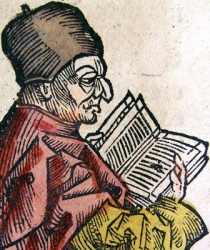
• Venerable Bede
• Father of English History
Born around the time England was finally completely Christianized. Raised from age seven in the abbey of Saints Peter and Paul at Wearmouth-Jarrow, and lived there the rest of his life. Benedictine monk. Spiritual student of the founder, Saint Benedict Biscop. Ordained in 702 by Saint John of Beverley. Teacher and author, he wrote about history, rhetoric, mathematics, music, astronomy, poetry, grammar, philosophy, hagiography, homiletics, and Bible commentary.
He was known as the most learned man of his day, and his writings started the idea of dating this era from the incarnation of Christ. The central theme of Bede's Historia Ecclesiastica is of the Church using the power of its spiritual, doctrinal, and cultural unity to stamp out violence and barbarism. Our knowledge of England before the 8th century is mainly the result of Bede's writing. He was declared a Doctor of the Church on 13 November 1899 by Pope Leo XIII.
672 at Wearmouth, England
25 May 735 of natural causes
1899 by Pope Leo XIII
lectors
• monk writing at a desk
• old monk dying amidst his community
• old monk with a book and pen
• old monk with a jug
He alone loves the Creator perfectly who manifests a pure love for his neighbour. - Saint Bede the Venerable
On Tuesday before the feast of the Ascension, Bede's breathing became labored and a slight swelling appeared in his legs. Nevertheless, he gave us instruction all day long and dictated cheerfully the whole time. It seemed to us, however, that he knew very well that his end was near, and so he spent the whole night giving thanks to God. At daybreak on Wednesday he told us to finish the writing we had begun. We worked until nine o'clock, when we went in procession with the relics as the custom of the day required. But one of our community, a boy named Wilbert, stayed with him and said to him, "Dear master, there is still one more chapter to finish in that book you were dictating. Do you think it would be too hard for you to answer any more questions?" Bede replied: "Not at all; it will be easy. Take up your pen and ink, and write quickly," and he did so. At three o'clock, Bede said to me, "I have a few treasures in my private chest, some pepper, napkins, and a little incense. Run quickly and bring the priest of our monastery, and I will distribute among them these little presents that god has given me." When the priests arrived he spoke to them and asked each one to offer Masses and prayers for him regularly. They gladly promised to do so. The priests were sad, however, and they all wept, especially because Bede had said that he thought they would not see his face much longer in this world. Yet they rejoiced when he said, "If it so please my Maker, it is time for me to return to him who created me and formed me out of nothing when I did not exist. I have lived a long time, and the righteous Judge has taken good care of me during my whole life. The time has come for my departure, and I long to die and be with Christ. My soul yearns to see Christ, my King, in all his glory." He said many other things which profited us greatly, and so he passed the day joyfully till evening. When evening came, young Wilbert said to Bede, "Dear master, there is still one sentence that we have not written down." Bede said, "Quick, write it down." In a little while, Wilbert said, "There; now it is written down." Bede said, "Good. You have spoken the truth; it is finished. Hold my head in your hands, for I really enjoy sitting opposite the holy place where I used to pray; I can call upon my Father as I sit there." And so Bede, as he lay upon the floor of his cell, sang, "Glory be to the Father, and to the Son and to the Holy Spirit." And when he had named the Holy Spirit, he breathed his last breath. - from a letter on the death of Saint Bede written by the monk Cuthbert
"My soul proclaims the greatness of the Lord, any my spirit rejoices in God my savior." With these words Mary first acknowledges the special gifts she has been given. Above all other saints, she alone could truly rejoice in Jesus, her savior, for she knew that he who was the source of eternal salvation would be born in time in her body, in one person both her own son and her Lord. "For the Almighty has done great things for me, and holy is his name." Mary attributes nothing to her own merits. She refers all her greatness to the gift of one whose essence is power and whose nature is greatness, for he fill with greatness and strength the small and the weak who believe in him. She did well to add: "and holy is his name," to warn those who heard, and indeed all who would receive his words, that they must believe and call upon his name. For they too could share in everlasting holiness and true salvation according to the words of the prophet: "and it will come to pass, that everyone who calls on the name of the Lord will be saved." This is the name she spoke of earlier when she said "and my spirit rejoices in God my savior." - from a homily by Saint Bede
https://catholicsaints.info/saint-bede-the-venerable/
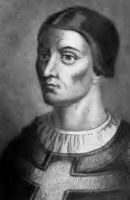
• Hildebrand of Soana
• Ildebrando di Soana
Educated in Rome, Italy. Benedictine monk. Chaplain to Pope Gregory VI. In charge of the Patrimony of Saint Peter. Reformer and excellent administrator. Chosen the 152nd pope, but he declined the crown. Chief counselor to Pope Victor II, Pope Stephen IX, Pope Benedidct X, and Pope Nicholas II. 157th pope.
At the time of his ascension, simony and a corrupt clergy threatened to destroy faith in the Church. Gregory took the throne as a reformer, and Emperor Henry IV promised to support him. Gregory suspended all clerics who had purchased their position, and ordered the return of all purchased church property. The corrupt clergy rebelled; Henry IV broke his promise, and promoted the rebels. Gregory responded by excommunicating anyone involved in lay investiture. He summoned Henry to Rome, but the emperor's supporters drove Gregory into exile. Henry installed the anti-pope Guibert of Ravenna, who was driven from Rome by Normans who supported Gregory; the Normans were, themselves, so out of control that the people of Rome drove out them and Gegory. The Pope then retreated to Salerno, Italy where he spent the remainder of his papacy.
c.1020 in Soana (modern Sovana), Italy as Hildebrand of Soana
22 April 1073
25 May 1085 at Salerno, Italy of natural causes
1728 by Pope Benedict XIII (equipollent canonization)
Now, my dearest brothers, listen carefully to what I tell you. All those throughout the world who are numbered as Christian and who truly acknowledge the Christian faith know and believe that the blessed Peter, the prince of the apostles, is the father of all Christians and, after Christ, the first shepherd, and that the holy Roman Church is the mother and teacher of all the churches. Therefore, if you believe this and hold to it without hesitation, I ask you and enjoin upon you by Almighty God - I your brother and unworthy teacher as I am - to support and assist your father and your mother if you wish to have, through them, the remission of all your sins, along with blessings and grace in this world and in the life to come. May almighty God, from whom all good things come, continually enlighten your minds and fill them with love for him and for your neighbor, so that by your devotion you may deserve to make this father and mother of whom I have spoken your debtors and enter without shame into their company. Amen. - from a letter by Pope Saint Gregory VII
https://catholicsaints.info/pope-saint-gregory-vii/
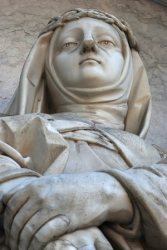
Mary-Magdalen de'Pazzi
Catherine received a religious upbringing. She was initially sent to a convent at age 14, but was taken back home by her family who opposed her religious vocation and wanted her to marry well. They eventually gave in, and Catherine became a Carmelite of the Ancient Observance at 16, taking the name Sister Mary Magdalen. Mystic. Led a hidden life of prayer and self-denial, praying particularly for the renewal of the Church and encouraging the sisters in holiness.
1566 at Florence, Italy as Catherine
25 May 1607 of natural causes
28 April 1669 by Pope Clement IX
• against bodily ills or sickness; sick people
• against sexual temptation
Prayer ought to be humble, fervent, resigned, persevering, and accompanied with great reverence. One should consider that he stands in the presence of a God, and speaks with a Lord before whom the angels tremble from awe and fear. - Saint Mary Magdalen de Pazzi
Come, Holy Spirit. Spirit of truth, you are the reward of the saints, the comforter of souls, light in the darkness, riches to the poor, treasure to lovers, food for the hungry, comfort to those who are wandering; to sum up, you are the one in whom all treasures are contained. Come! As you descended upon Mary that the Word might become flesh, work in us through grace as you worked in her through nature and grace. Come! Food of every chaste thought, fountain of all mercy, sum of all purity. Come! Consume in us whatever prevents us from being consumed in you. - from the writings of Saint Mary Magdalene de Pazzi A little drop of simple obedience is worth a million times more than a whole vase of the choicest contemplation. - Saint Mary Magdalen de' Pazzi
https://catholicsaints.info/saint-mary-magdalen-of-pazzi/
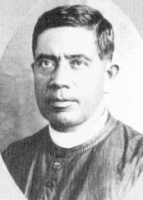
21 May as one of the Martyrs of the Mexican Revolution
Born to a farm family, and worked as a shepherd in his youth. He entered the seminary at 19, and served as parish priest at Totatiche, Mexico. Helped found schools, a newspaper, catechism centers for children and adults, carpentry shops, and an electric plant to power the mills. Worked with the indigenous people to form agrarian cooperatives with the town's people. Noted for his devotion to Our Lady.
When the anti-Church government closed all seminaries, Father Cristobal gathered displaced seminarians, and started his own seminary; it was quickly suppressed. He formed another, and another, and when they were all closed, the seminarians conducted classes in private homes.
He wrote and preached against armed rebellion, but was falsley accused of promoting the Cristero guerilla revolt. Arrested on 21 May 1927 while en route to celebrate Mass at a farm. In prison he gave away his few remaining possessions to his executioners, gave them absolution, and without a trial, he was martyred with Saint Agustin Caloca.
30 July 1869 in La Sementera, Totatiche, Jalisco, Mexico
shot on 25 May 1927 at Colotlán, Jalisco, Mexico
21 May 2000 by Pope John Paul II during the Jubilee of Mexico
I am innocent and I die innocent. I forgive with all my heart those responsible for my death, and I ask God that the shedding of my blood serves toward the peace of our divided Mexico. - Saint Cristobal just before his executioners fired
https://catholicsaints.info/saint-cristobal-magallanes-jara/
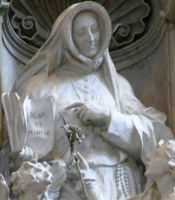
Daughter of Jacques Barat, a cooper who worked with the vineyards for whom he supplied barrels. Naturally bright, she was educated by her older brother Louis, a monk. As Madeline grew older, her brother feared she would be exposed to too much of the world, and so brought her to Paris, France with him. The girl wanted to be a Carmelite lay sister, but with Father Joseph Varin and three other postulants, she founded the Society of the Sacred Heart on 21 November 1800; the Society is devoted to the Sacred Heart, and dedicated to teaching girls. Nun. Teacher. Superior General of the Society at age 23, she held the position for 63 years. Receiving papal approval of the Society in 1826, she founded 105 houses in many countries; Saint Rose Phillippine Duschene and four companions brought the Society to the United States.
12 December 1779 at Joigny, France
25 May 1865 at Paris, France of natural causes
24 May 1925 by Pope Pius XI
Let us attach ourselves to God alone, and turn our eyes and our hopes to Him. - Saint Madeline
To suffer myself, and not to make others suffer. - Saint Madeline
Our Lord who saved the world through the Cross will only work for the good of souls through the Cross. - Saint Madeline
God does not ask of us the perfection of tomorrow, nor even of tonight, but only of the present moment. - Saint Madeline Sophie Barat
https://catholicsaints.info/saint-madeline-sophie-barat/
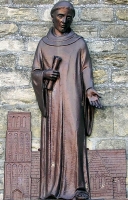
Adhelm, Aldelmus
Son of Centa, he was a Saxon and related to the King of Wessex. Lived for a while as a hermit near Wiltshire, England. Monk at Malmesbury Abbey in Wiltshire. Spiritual student of Saint Maeldulph and Saint Adrian of Canterbury. Teacher and spiritual director.
Abbot at Malmesbury c.685. Instituted Benedictine reforms, and the house became a model for those around it. Founded monasteries at Frome and Brandford-on-Avon, and built three churches in Malmesbury, one of which survives today. During one of the church constructions, a roof beam was cut too short; Aldhelm prayed over it, and it lengthened. Around the year 700 Aldhelm installed the first church organ in England.
He was a tireless preacher - legend says that one sermon lasted so long that his staff took root and became a tree again. Spiritual writer known internationally in his day. One of the founders of Anglo-Latin poetry. A musician, he was skilled in the harp, fiddle and pipes, and known as a skilled and popular singer. He travelled to Rome to meet with Pope Saint Sergius I and helped settle disputes on matters of theology and practice between the Celtic and Anglo-Saxon churches. Bishop of Sherborne from 705 until his death.
640 in England
• 25 May 709 at Doulting, Somerset, England of natural causes
• buried at Saint Michael the Archangel church, Malmesbury, England
• relics translated to a silver shrine in 857
bishop in a library
https://catholicsaints.info/saint-aldhelm-of-sherborne/
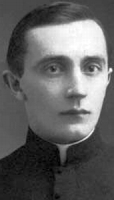
• Mykola Cehelskyj
• Nicholas Tsehelsky
27 June as one of the Martyrs Killed Under Communist Regimes in Eastern Europe
Greek Catholic. Studied theology at the university of Lviv, Ukraine, graduating in 1923. Married with two sons and two daughters. Ordained on 5 April 1925. Parish priest at Soroka, Hrymailivsk deanery, where he built the church. Pastor of the Archeparchy of Lviv for the Ukrainians. Intimidated, then threatened, then beaten by Soviet authorities after World War II. Arrested for his faith on 28 October 1946; sentenced to ten years imprisonment on 27 January 1947, he was sentenced to ten years the forced labour camps in Mordovia, Russia. Died in prison, one of the Martyrs Killed Under Communist Regimes in Eastern Europe.
17 December 1896 at Strusiv, Ternopil District, Ukraine
25 May 1951 at the forced labour camp at Mordovia, Russia
27 June 2001 by Pope John Paul II in Ukraine
https://catholicsaints.info/blessed-mykola-tsehelskyi/
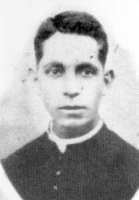
• Agustin Caloca
• Augustine Caloca
21 May as one of the Martyrs of the Mexican Revolution
Studied at the seminary in Guadalajara, Mexico until it was closed down by anti-clerical government forces. He resumed his studies in the covert Auxiliary Seminary of Our Lady of Guadalajara founded by Saint Cristobal Magallanes. Ordained on 5 August 1923. Prefect of the Auxiliary Seminary. Arrested for his continued religious work, and for unfounded suspicion of involvement in the armed Cristeros rebellion. Martyred with Saint Cristobal Magallanes.
5 May 1898 at Teul, Zecatecas, Mexico
• shot on 25 May 1927 at Colotitlan, Jalisco, Mexico
• relics at the chapel at Teul, Zecatecas, Mexico
21 May 2000 by Pope John Paul II during the Jubilee of Mexico
https://catholicsaints.info/saint-agustin-caloca-cortes/
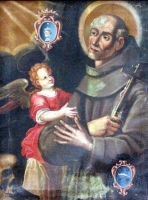
29 August (enshrinment of relics)
Franciscan friar.
1460 in Anghiari, Italy
• 1510 in Empoli, Italy
• relics enshrined in the church of Santa Croce in Anghiari, Italy
• public veneration in the church of Santa Croce in Anghiari, Italy approved on 19 June 1635 by the Bishop of Sansepolcro, Italy
• public cultus approved for the diocese of Sansepolcro, Italy on 2 May 1830 by Bishop Annibale Tommasi
• public cultus approved in 1907 by Bishop Giovanni Volpi of Arezzo, Italy
• relics re-enshrined in a new reliquary and new altar in 1950 by Catholic Action
Associazione della Gioventù Cattolica Maschile (chosen in 1922)
https://catholicsaints.info/blessed-bartolomeo-magi-di-anghiari/
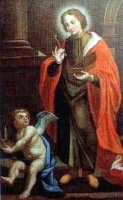
Gerio, Gerius, Gery, Girio, Roger
Born to the French nobility. Raised in a pious family; he was a Franciscan tertiary at age 5. Lived as a hermit in a cave with his brother from age 18 to 20. They became somewhat famous as holy men, which they took as a sign that they should become pilgrims in order to escape their visitors and the temptations that came with them. Gerard died on the way to Jerusalem. Miracles and healings have been reported at his tomb, especially helping people with headaches or epilepsy.
1275 in southern France
1298 at Montesanto, Italy of natural causes
by Pope Benedict XIV
• against epilepsy; epileptics
• against headaches
• Montesanto, Italy
https://catholicsaints.info/blessed-gerard-of-lunel/
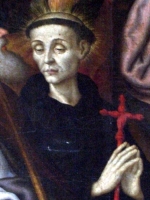
• James Philippi
• Andrea Bertoni
Born to a poor family. Joined the Servites at age 9. Priest. Procurator of the Servite friary in Faenza, Italy until his death.
1444 at Faenza, Italy as Andrea Bertoni
• 25 May 1483 at Faenza, Italy of natural causes
• re-interred in the Manfredi chapel on 15 April 1594
• the church was damaged in November 1944 during World War II, and Blessed James was re-interred at the < ahref="altar">altar of Saint Charles Borromeo in the cathedral of Faenza
22 July 1761 by Pope Clement XIII (cultus confirmed)
Faenza, Italy (chosen by the city council on 14 July 1762)
https://catholicsaints.info/blessed-james-bertoni/
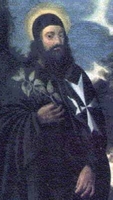
Inspired by the example of Saint Francis of Assisi, Gerardo gave all his wealth to the poor and withdrew to live as a prayerful hermit. He came into the city for Mass, to pray in churches for the souls in Purgatory and the conversion of non-Christians, to care for the sick, and to offer any help he could give to pilgrims. Miracle worker.
c.1174 in Villamagna, Italy
13 or 25 May (records vary) in 1242, 1245 or 1254 (records vary) in Villamagna, Italy of natural causes
18 May 1833 by Pope Gregory XVI (cultus confirmation)
https://catholicsaints.info/blessed-gerardo-mecatti/
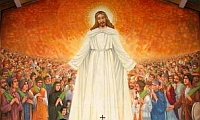
• Matteo Nguyen Van Phuong
• Matthew Nguyen Van Phuong
24 November as one of the Martyrs of Vietnam
Married layman catechist in the apostolic vicariate of North Cochinchina. Tortured and martyred in the persecutions of emperor Tu-Duc.
c.1808 in Ke Lái, Quang Bình, Vietnam
beheaded on 26 May 1861 near Dong Hoi, Quang Bình, Vietnam
19 June 1988 by Pope John Paul II
https://catholicsaints.info/saint-mattheo-nguyen-van-dac-phuong/
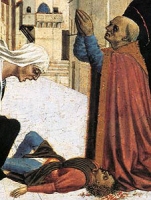
Zanobi, Zenobio
Born a pagan, Zenobius converted and was baptized as an adult. Priest. Archdeacon. Friend of Saint Ambrose of Milan. Counselor to Pope Saint Damasus I. First bishop of Florence, Italy. Worked with Saint Eugene of Florence and Saint Crescentius. Fought Arianism. Miracle worker, reviving five people from the dead.
25 May 417 of natural causes
Florence, Italy
• bishop bringing a child or man back to life
• flowering tree
https://catholicsaints.info/saint-zenobius-of-florence/
Well-educated Mercedarian friar. Chosen 15th Master-General of the Mercedarians in 1405, he worked to build up the interior life of its members, and the financial resources they used to ransom Christians from slavery in Muslim countries. Served as diplomat for the King of Aragon. Attended the Council of Perpignan, France; attended the Council of Constance, Switzerland. A great believer in the unity of the Church, he worked to overcome the Western Schism. Chosen bishop of Lyons, France, but declined.
25 May 1417 in Constance, Switzerland of natural causes
https://catholicsaints.info/blessed-antonio-caixal/

Peter Doan Van Van
24 November as one of the Martyrs of Vietnam
Layman catechist in the apostolic vicariate of West Tonkin (modern Vietnam). Martyred in the persecutions of emperor Tu Duc.
c.1780 in Ke Bói, Hà Nam, Vietnam
25 May 1857 in Son Tây, Ha Tay, Vietnam
19 June 1988 by Pope John Paul II
https://catholicsaints.info/saint-phero-doan-van-van/
Grandson of King Ismael of Granada of convert from Islam; son of Ozmin Aben Adriz a convert from Islam. Studied in Salamanca, Spain. Joined the Mercedarians in Valladolid, Spain. Commander of the convent of Córdoba, Spain for 13 years. Mercedarians provincial of Castile, Spain in 1407. Made redemption trips to Africa in 1415 and 1427 to ransom Christians who had been enslaved by Muslims. During the latter trip, he was imprisoned, tortured and executed by the Moors for refusing to deny Christianity. Martyr.
1428 in Granada, Spain
https://catholicsaints.info/blessed-juan-of-granada/
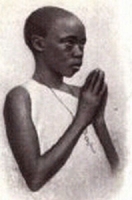
• Dionysius Ssebuggwawo
• Dionysius Sebuggwawo
• Denis Sebuggwawo
3 June as one of the Martyrs of Uganda
Musu clan. Convert. One of the Martyrs of Uganda who died in the Mwangan persecutions.
at Buganda, Uganda
beheaded on 25 May 1886 at Munyonyo, Uganda
18 October 1964 by Pope Paul VI at Rome, Italy
https://catholicsaints.info/saint-denis-ssebuggwawo/
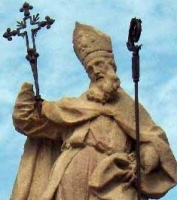
Bishop of Milan, Italy in 351. Exiled to Cappadocia in 355 by the Arian Emperor Constantius for defending Saint Athanasius of Alexandria.
• 359 in Cappadocia (in modern Turkey) of natural causes
• relics brought to Milan, Italy in 375 by Saint Ambrose of Milan
https://catholicsaints.info/saint-dionysius-of-milan/
Born to the Catalan nobility. Joined the Mercedarians at age 18. Made redemption trips to Africa in 1415 and 1427 to ransom Christians who had been enslaved by Muslims. During the latter trip, he was imprisoned, tortured and executed by the Moors for refusing to deny Christianity. Martyr.
Lerida, Spain
shot with arrows in 1428 in Granada, Spain
https://catholicsaints.info/blessed-pedro-malasanch/
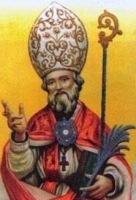
• Canion
• Canione
Convert to Christianity. Bishop of a region of the North African coast.
African
• archdiocese of Acerenza, Italy
• Acerenza, Italy
• Calitri, Italy
https://catholicsaints.info/saint-canio/
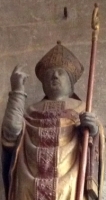
Mauxe
Brother of Saint Victorinus of Evreux. Missionary to Gaul, sent by Pope Damasus I. Martyr.
c.384 bear Evreaux, France
https://catholicsaints.info/saint-maximus-of-evreux/
Donatus, Dumhade, Dumhaid, Duncad, Dunchad, Dunichad
Monk and abbot in Ireland. Abbot of Iona Abbey. Known for his personal piety and as a miracle worker.
Ireland
717
https://catholicsaints.info/saint-dunchadh-of-iona/
Married to Saint Injuriosus of Auvergne. The two, known as the Les Deux Amants, lived their lives together as holy and chaste lay people.
c.550
https://catholicsaints.info/saint-scholastica-of-auvergne/
Married to Saint Scholastica of Auvergne.The two, known as the Les Deux Amants, lived their lives together as holy and chaste lay people.
c.550
https://catholicsaints.info/saint-injuriosus-of-auvergne/
• Leo of Mantenay
• Leone of...
Monk. Spiritual student of Saint Romanus. Abbot of Mantenay Abbey near Troyes, France.
c.550
https://catholicsaints.info/saint-leo-of-troyes/
Abbot of Cornelimünster Abbey near Aachen, Germany. Killed by Viking raiders.
881 at Bercheim, Germany
https://catholicsaints.info/saint-egilhard-of-cornelimunster/
One of a group of four martyrs executed together. No details about them have survived.
Dorostorum, Mysia, Asia Minor
https://catholicsaints.info/saint-pasicrates-of-dorostorum/
One of a group of four martyrs executed together. No details about them have survived.
Dorostorum, Mysia, Asia Minor
https://catholicsaints.info/saint-valentio-of-dorostorum/
Brother of Saint Maximus of Evreux. Missionary to Gaul, sent by Pope Damasus I. Martyr.
c.384 bear Evreaux, France
https://catholicsaints.info/saint-victorinus-of-evreux/
Sensia, Sentias, Sentius, Senzi, Senzius
Fifth-century hermit.
Blera, Italy
https://catholicsaints.info/saint-senzio-of-bieda/
Deacon at Saint Bertin Abbey. Murdered by invading Danes. Martyr.
862
https://catholicsaints.info/saint-winebald-of-saint-bertin/
Monk of Saint Bertin Abbey. Murdered by invading Danes. Martyr.
862
https://catholicsaints.info/saint-gerbald-of-saint-bertin/
Deacon at Saint Bertin Abbey. Murdered by invading Danes. Martyr.
862
https://catholicsaints.info/saint-worad-of-saint-bertin/
CatholicSaints.Info Portable Edition